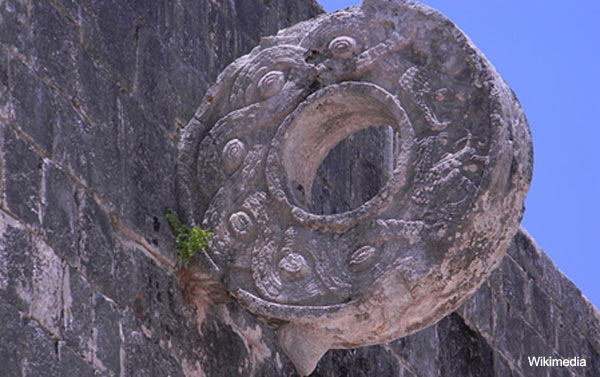Archaeologists uncover ancient Maya ball court used as a ritual centre
Workers were constructing a school’s basketball court in the municipality of Maxcanu in the Yucatan region of Mexico when they stumbled upon an ancient ball game court which was used as a ritual centre.
An archaeologist with The Instituto Nacional de Antropología e Historia (INAH, National Institute of Anthropology and History), who attended the site told the school: “The Mayans are way ahead of you, you can’t build your court because a pre-Hispanic one already exists here: it’s a Ball Game court.”
More than 1300 ball courts of varying sizes have been found in Mesoamerica, all made up of a long narrow playing field flanked by two walls. The rules of the ballgame, which was played since at least 1400 BC, are not precisely known. Spanish records state that the game was played by two teams of two to four players. A hard ball made of rubber had to be kept in the air by hitting it with the hips, thighs or upper arms and bouncing it of the side walls. The sport had different versions in different places during the millennia, and a newer more modern version of the game, ulama, is still played in a few places by the indigenous population.

The Great Ball Court of Chichen Itza, the largest ball court in ancient Mesoamerica. Photo credit: Wikipedia
In the Postclassical period, the Maya began placing vertical stone rings in the centre of each of the side walls. Any player who succeeded in passing the ball through the stone ring was immediately declared the winner. As the holes in the ring were not much bigger than the ball this must have been a very rare event.
The ball game had important ritual aspects, and major formal ballgames were held as ritual events, often featuring human sacrifice. The association between human sacrifice and the ballgame did not appear until the Classical Era, and was particularly associated with the Maya cultures, where the most explicit depictions of human sacrifice can be seen on the ball court panels—for example at Chichen Itza (900–1200 AD). The reliefs show the sacrifice of practiced ballplayers, perhaps the captain of the losing team.

A relief from the Great Ball Court of Chichen Itza. Photo credit: Wikimedia
One of the activities during the Ball Games is narrated in the Popol Vuh: “the mythical twins Hunahpu and Ixbalanque faced, in ball player’s getup, the lords of the underworld who are finally defeated, thus conquering death and giving way to life; this myth continues with the resurrection of the twins’ father who transforms into the corn god”. This suggests there is a link between this deity and the ritual game that took place in these sacred spaces.
The ball court found at the school in Maxcanu was located at the foot of a mountain in a strategic location which was prime agricultural land, which could suggest the ball game was linked with an ancient ritual associated with the corn god and the beginning of the agricultural season. To the Mayans, the sun was one of the most important elements in their rituals, it signalled the change in seasons and the start of a pertinent time to prepare the land for corn cultivation. The ball is an analogy of the sun and the movements of the game are an analogy of the path of this celestial body. It was believed that playing ball engaged one in the maintenance of the cosmic order of the universe and the ritual regeneration of life.
There is also evidence to suggest the ball games were tied in with astronomical events. Watchtower structures found several years ago at Chichen Itza were well position to observe the equinoxes and solstices. Archaeologist Jose Huchim commented that the five passages found at Chichen Itza had celestial alignments: “one of them marks the winter solstice, the central passages mark the equinoxes and the north passages mark the summer solstice”.
Mexican archaeologist Jose Huchim Herrera says that there are many layers of ritual significance that the ball game had for the culture.
Featured image: Stone ring used in Maya ball games. Photo credit: Wikimedia

















